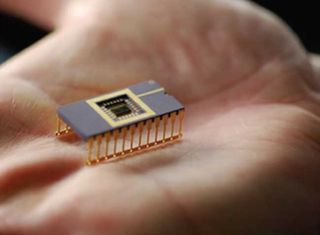Tiny Nuclear Batteries to Power Micro Devices

Typical chemical batteries just don't cut it when a device needs to run for years without fail. Enter the betavoltaics, or tiny nuclear batteries that harvest energy from radioactive sources such as tritium.
Now a company called Widetronix has developed new betavoltaics that can run for up to 25 years and perhaps power tiny devices in everything from military hardware to smartphone sensors.
Nuclear in this case does not refer to fission power and splitting atoms, but instead means the natural decay of electrons given off by radioactive sources. A semiconductor such as silicon harvests the electrons in betavoltaics — similar to how semiconductors in photovoltaic cells collect photons from solar energy.
Microwatts envisioned
The first betavoltaics began by using silicon semiconductors over 50 years ago. But Widetronix has created silicon carbide semiconductors which appear as tiny chips, and can function for years while resisting radioactive damage.
"It is our professional opinion that the higher the efficiency, the lower the device cost, [and the] smaller the unit volume," said Jonathan Greene, CEO of Widetronix in Ithaca, New York.
Keep in mind that these won't run your netbook or even iPhone anytime soon. The betavoltaics currently only provide nanowatts of power, where one nanowatt represents a billionth of a watt. But Widetronix has already begun experimenting with stacking chips together to create a nuclear battery that can provide a microwatt of power, or one millionth of a watt.
Sign up for the Live Science daily newsletter now
Get the world’s most fascinating discoveries delivered straight to your inbox.
Such tiny power sources could enable a growing swarm of tiny devices in civilian life. Greene said that his company is looking toward "ultra low power implantable devices" that might help physicians monitor the health of patients.
Supporting MEMS and the military
The growing popularity of Micro-Electro-Mechanical Systems (MEMS), which enable "systems-on-a-chip" and other electronic devices on incredibly small scales, could also benefit from betavoltaics. They may help transform smart phones into do-all devices that monitor human health and the environment.
"In general, the opportunity space is around wireless sensors — working with a host of complimentary power storage and energy harvesting technologies," Greene told TopTenREVIEWS. "[Betavoltaics] in my view can be at the heart of the system providing long life reliability and small size."
The U.S. military also likes what it sees in betavoltaics. Lockheed Martin has already begun testing some of the Widetronix batteries for use in anti-tamper military devices, which prevent enemies from tinkering with missiles or other sensitive military hardware. More powerful betavoltaics could someday power devices that help U.S. commanders keep track of their warfighters, aircraft, vehicles and drones.
Back on the civilian side, Greene says that betavoltaics-powered sensors could monitor the condition of bridges, roads and buildings. Commercial airline fleets might also use such sensors to alert mechanics about when an aircraft requires maintenance.
Widetronix still wants to examine new nuclear isotopes, such as Promethium-147, as sources of more power in future batteries. But the first commercial products are already slated for rollout sometime in 2011 — most people just probably won't notice the tiny batteries powering their devices.
This article was provided by TopTenREVIEWS.

